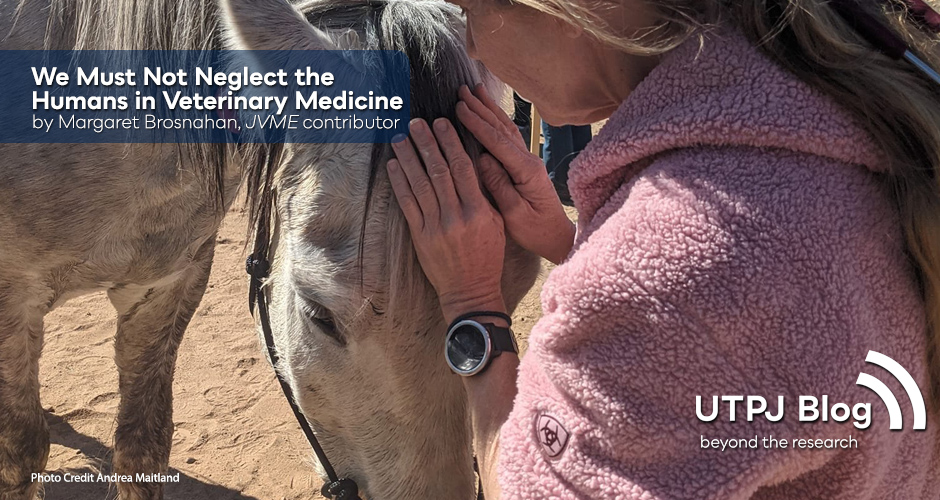
Written by guest blogger Margaret Brosnahan.
As a scholar, diving into unexplored territory is always exciting and rewarding, but introducing new ideas to colleagues can be frightening. It was with this combination of excitement and trepidation that I sent off my paper entitled “Life, Death, and Humanity in Veterinary Medicine: Is it Time to Embrace the Humanities in Veterinary Education?” to the Journal of Veterinary Medical Education. This work was the culmination of three years of immersion into the fields of narrative medicine and medical humanities, disciplines that are already well known in medical education but virtually unheard of within the veterinary profession. I had discovered narrative medicine quite by accident one day when a paper by Dr. Rita Charon appeared in the results of a literature search on methods in clinical teaching. As someone with a humanities background, discovering Dr. Charon’s work was a coming home of sorts. The benefits of including the humanities in health professions education seemed obvious to me, and as a member of a profession currently plagued by high rates of attrition, mental health concerns, financial stressors on ourselves and our clients, marginalization of some of our own colleagues within the profession, and underservice to significant populations of animal owners, I wanted to learn more. My belief in the value of this approach to health professions education now runs deep, but convincing veterinary colleagues of that is sometimes difficult.
I welcome this opportunity to address a couple of the snap judgements that educators and clinicians often make about narrative medicine and medical humanities, potentially dismissing these valuable educational approaches before giving them a chance. The first is that narrative medicine is simply a method of glorified history taking, or sporadic modules of reading for fun . It is in fact so much more than that. Training in narrative medicine is a deeply transformative, experiential process, something that became very clear to me as I progressed through Columbia University’s Certificate in Narrative Medicine program. While the ultimate goal of narrative medicine is better care of the patient, I found that the intimate engagement with literature, poetry, and visual arts, and the sharing of reflections on these pieces in communion with others, was profoundly humanizing in a way that has carried over into my clinical work. Viewing the humans in veterinary medicine through this fresh lens has made an already rewarding practice orders of magnitude more so. The second judgment often made is that the incorporation of narrative medicine and medical humanities into a health professions curriculum will compromise the scientific and medical rigor of a competency-based program. When structured appropriately, these modules have the opposite effect, providing moments of pause and reflection that can enhance rather than detract from the core material.
My primary objective in writing this paper was to introduce these disciplines to veterinary educators, but it is also my hope that clinicians and scholars engaged with narrative medicine and medical humanities in the human health professions will find the veterinary perspective useful in their practices. Questions such as “Do you live with pets?” and “How will your illness affect your ability to care for them?” or other efforts to honour the role that animals may play in the lives of patients, have the potential to enhance the physician – patient encounter. Additionally, I encourage those who teach undergraduate liberal arts to students heading for graduate health professions training to consider offerings in the medical and veterinary humanities. I can’t imagine a greater gift to a future healer than starting out with this foundation that has taken many of us, myself included, decades to discover.
 DR. MARGARET BROSNAHAN is an Associate Professor of Equine Internal Medicine at the Midwestern University College of Veterinary Medicine in Glendale, AZ. She earned her undergraduate degree in History from Bates College, and recently completed both an MA in Medical Humanities from Creighton University and a Certificate in Narrative Medicine from Columbia University. Her clinical training includes a DVM from Tufts University, an internship in Large Animal Medicine and Surgery at the University of Minnesota, and a residency in Equine Internal Medicine at Oklahoma State University. She is a Diplomate of the American College of Veterinary Internal Medicine in Large Animal Internal Medicine, and also holds a PhD in Immunology from Cornell University.
DR. MARGARET BROSNAHAN is an Associate Professor of Equine Internal Medicine at the Midwestern University College of Veterinary Medicine in Glendale, AZ. She earned her undergraduate degree in History from Bates College, and recently completed both an MA in Medical Humanities from Creighton University and a Certificate in Narrative Medicine from Columbia University. Her clinical training includes a DVM from Tufts University, an internship in Large Animal Medicine and Surgery at the University of Minnesota, and a residency in Equine Internal Medicine at Oklahoma State University. She is a Diplomate of the American College of Veterinary Internal Medicine in Large Animal Internal Medicine, and also holds a PhD in Immunology from Cornell University.
“Life, Death, and Humanity in Veterinary Medicine: Is It Time to Embrace the Humanities in Veterinary Education?” was published in the Journal of Veterinary Medical Education 50.6 and is Free to Read until April 19th.
Comments on this entry are closed.